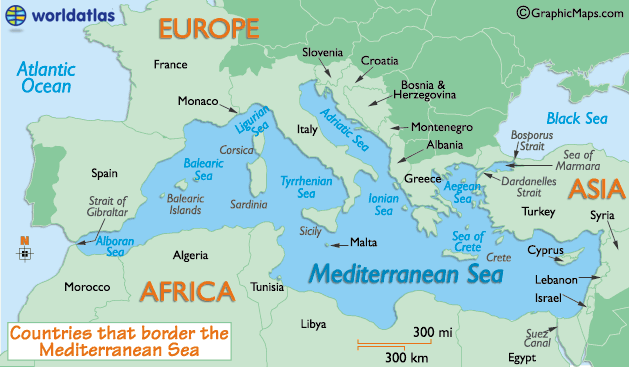ENVIRONMENT
Mediterranean could become a 'sea of plastic': WWF
The Mediterranean could become a "sea of plastic", the WWF warned on Friday in a report calling for measures to clean up one of the world's worst affected bodies of water.
The WWF said the Mediterranean had record levels of "micro-plastics," the tiny pieces of plastic less than five millimetres (0.2 inches) in size which can be found increasingly in the food chain posing a threat to human health.
"The concentration of micro-plastics is nearly four times higher" in the Mediterranean compared with open seas elsewhere in the world, said the report, "Out of the Plastic Trap: Saving the Mediterranean from Plastic Pollution."
The problem, as all over the world, is simply that plastics have become an essential part of our daily lives while recycling only accounts for a third of the waste in Europe.
Plastic represents 95 percent of the waste floating in the Mediterranean and on its beaches, with most coming from Turkey and Spain, followed by Italy, Egypt and France, the report said.
The WWF said the Mediterranean had record levels of "micro-plastics," the tiny pieces of plastic less than five millimetres (0.2 inches) in size which can be found increasingly in the food chain posing a threat to human health.
"The concentration of micro-plastics is nearly four times higher" in the Mediterranean compared with open seas elsewhere in the world, said the report, "Out of the Plastic Trap: Saving the Mediterranean from Plastic Pollution."
The problem, as all over the world, is simply that plastics have become an essential part of our daily lives while recycling only accounts for a third of the waste in Europe.
Plastic represents 95 percent of the waste floating in the Mediterranean and on its beaches, with most coming from Turkey and Spain, followed by Italy, Egypt and France, the report said.

https://www.google.com/maps/place/Mediterranean+Sea/@36.6578209,-3.0446471,4z/data=!3m1!4b1!4m5!3m4!1s0x131421b81c473c9f:0x2e93598afeccf840!8m2!3d34.5531284!4d18.0480105
To tackle the problem, there has to be an international agreement to reduce the dumping of plastic waste and to help clear up the mess at sea, the WWF said.
All countries around the Mediterranean should boost recycling, ban single-use plastics such as bags and bottles, and phase out the use of micro plastics in detergents or cosmetics by 2025.
The plastics industry itself should develop recyclable and compostable products made out of renewable raw materials, not chemicals derived from oil.
Indidviduals too have their role to play, making personal choices such as to use combs or kitchen utensils made of wood, not plastic, the WWF said.
WHO THEY(WWF) ARE
For 50 years, WWF has been protecting the future of nature.
The world’s leading conservation organization, WWF works in 100 countries and is supported by more than one million members in the United States and close to five million globally. WWF's unique way of working combines global reach with a foundation in science, involves action at every level from local to global, and ensures the delivery of innovative solutions that meet the needs of both people and nature.
HOW THEY(WWF) WORK

FORESTS
Conserve the world's most important forests.
OCEANS
Safeguard healthy oceans and marine livelihoods.
FRESH WATER
Secure water for people and nature.
WILDLIFE
Protect the world's most important species.
FOOD
Double net food availability; freeze its footprint.
CLIMATE
Create a climate-resilient and zero-carbon world, powered by renewable energy.
These things are not just “nice to have”. . . they are “need to haves.” They are the things that make it possible for us to live. And so, to ensure our very survival, they must be kept safe.
It’s a big job. And no one person or organization can do it alone.
But together we can.
WWF-US is part of the WWF global network which has worked for more than 50 years to protect the future of nature. In 2016, WWF embraced a bold new strategy and transformation designed to make the organization stronger and even more effective in tackling the challenges ahead. In this video, Marco Lambertini, Director General, WWF International, talks about WWF’s new way of working and commitment to conservation results.
Together, we can achieve WWF’s mission to conserve nature and reduce the most pressing threats to the diversity of life on Earth.
Together, in partnership with foundations, governments, businesses, communities, individuals and our more than six million members, we can conserve many of the world’s most ecologically important regions.
Together, we can
- Protect and restore species and their habitats
- Strengthen local communities' ability to conserve the natural resources they depend upon
- Transform markets and policies to reduce the impact of the production and consumption of commodities
- Ensure that the value of nature is reflected in decisions made by individuals, communities, governments and businesses
- Mobilize hundreds of millions of people to support conservation
Together, we can protect life on our planet—including our own.
Because together, anything is possible.
together possible
“Conservation endures as a living discipline because it is inhabited by a magnificent collection of people. Only by working together can we create solutions to the most vexing problems we face.”
Carter Roberts
President & CEO
President & CEO
7 Ways you can help save the ocean

Every living thing depends on the ocean. Covering more than 70% of our planet’s surface, it contains the largest diversity of life on Earth and affects everything from global weather patterns to food systems. So when we hear the ocean is in trouble from the effects of climate change, pollution and overfishing, it’s easy to feel powerless. While many of these issues will require leadership from governments and businesses, there are plenty of small actions you can take that will make a big difference for the ocean.
1. Skip the straws
Single-use plastics—such as water bottles, take-out packaging, plastic bags, and straws—create ocean pollution that can destroy ecosystems and endanger marine life. With 8 million tons of plastic dumped into the ocean each year, there could be a pound of plastic for every three pounds of fish in the ocean within the next decade alone. To minimize your impact, remove unnecessary single-use plastics from your daily habits. Even eliminating straws could go a long way towards reducing ocean debris. If every American sipped out of just five fewer straws per year, we could keep more than 1.5 billion straws out of landfills—and our ocean.
2. Check the label
Global fish populations are rapidly dwindling due to high demand and unsustainable fishing practices. Help keep fisheries and fish stocks healthy by choosing sustainable seafood when you grocery shop or dine out. The easiest way to make sure your seafood is sustainable? Look for the MSC blue fish on your seafood—a certification that ensures your fish can be traced back to a sustainably managed fishery.
3. Reduce your carbon emissions
In the last half-century, the ocean has absorbed 90% of the excess heat created by burning fossil fuels. That’s led to warmer waters, which can affect where fish swim, how marine species reproduce, how fast sea levels rise, and even weather events on land. Decrease the effects of climate change on the ocean by cutting your carbon footprint at home: turn off lights and unplug electronics when you’re not using them, adjust your thermostat, walk or ride your bike to work, and demand renewable energy options in your community
4. Travel smarter
Consider booking your next trip through a responsible travel company that’s committed to protecting wildlife, empowering local communities, and using guides who are aware of rules and best practices. Once you arrive at your destination, be respectful of marine life and habitats, such as nesting sea turtles on beaches and sensitive reef systems. And be discerning about your purchases. Purchasing certain items, such as coral jewelry, shark products, or tortoiseshell accessories (made from endangered hawksbill turtles) damages fragile ecosystems and threatens critically endangered species.
5. Increase your ocean IQ
The more you learn about the ocean, the better prepared you’ll be to inspire change—and help others do the same. Thankfully, there are many ways to educate yourself about the ocean and the challenges it faces, from books and documentaries to websites, museums, art exhibits, and more. If you’re an educator, check out WWF’s Wild Classroom, an online library of specially designed tools that will help you bring ocean conservation to your school.
6. Use your unique skills for good
Not a marine biologist? Not to worry. Consider joining an organization that works to protect ocean habitats or volunteering at local beach cleanups. Support local restaurants, grocery stores, and businesses in your community that offer sustainable seafood. Or contact your elected representatives to let them know you care about ocean-friendly policies.
7. Sign up, sign on, speak out
Being an advocate for the ocean can be as simple as speaking out about the importance of the vast ecosystem. Tell your friends and family why the ocean matters, and let our leaders know that you side with the ocean. Whether it’s defending the beauty of Alaska's Bristol Bay or asking your representative to Save Our Seas, WWF’s Action Center helps you take action now.
----------------------------------------------------------------------------------------------------------------------------------
India on the occasion of the World Environment Day on Tuesday pledged to eliminate all single-use plastics (items like carry bags, straws and water bottles among others) from the country by 2022 — the year which coincides with 75 years of the country's independence.
"We make a solemn pledge that we will eliminate all single-use plastics from our country," said Union environment minister Harsh Vardhan while referring to PM's idea of 'New India' by 2022.
"This India of our dreams (New India) will be single-use plastic free," the PM later emphasised on India's commitment towards protecting environment.
Being the global host of this year's World Environment Day, India's announcement to end use of single-use plastic in next four years is expected to send a strong message to the global community which is already threatened by the plastic menace due to its impact on marine ecosystems, water bodies and soils.
"Plastic threatens to become a menace to humanity. A lot of it never makes it to the recycling bin. Worse, a lot of it is non-biodegradable. India is preparing to join the 'Clean Seas Campaign' and make its contribution towards saving our oceans,"
The annual average per capita consumption of plastic in India is at 11 kg as against global average of 28 kg.
India showed global leadership by pledging to phase out single-use plastics by 2022: UN Environment chief
Calling the World Environment Day (WED) celebrations in India "historic", UN Environment chief Erik Solheim has said by announcing that it will phase out single-use plastics by 2022, India has demonstrated global leadership.
During an event to celebrate the WED-2018 on June 5 in New Delhi, Environment Minister Harsh Vardhan, in presence of Prime Minister Narendra Modi, pledged to eliminate single-use plastics from India by 2022.
"WED was truly historic. As global host, India took charge, organising hundreds of events around the country, from beach and river clean ups, to awareness-building efforts with young people," Solheim told PTI.
He said India made incredible announcements that will have a "definite impact" on the global fight against plastic pollution.
"By announcing that the country will phase out single-use plastics by 2022, India has demonstrated global leadership and it's now up to other countries to follow India's lead," the UN Environment chief said.
Recalling that he was honoured to be present when Prime Minister Modi signed on to the UN Environment's Clean Seas campaign, he said the programme will be stronger with India's support, sending a clear message to other countries, that all of us must come together to tackle the marine litter.
"While I know implementation is a challenge, I have absolutely no doubt that India will succeed and this will have a major impact on the world," Solheim said.
He previously said the WED will be a call to action and leadership and asserted India is the "perfect" place for that to happen.
World Environment Day celebrations began in the national capital and across India with the start of this month. Several workshops and thematic sessions were held in Delhi.
The pan-India events included cleanliness campaigns by state governments, cleaning of 24 beaches and 24 rivers in 19 states, making national parks and sanctuaries plastic free, media as well as social media campaigns and organising 'Envithon' mini-marathons in five cities, besides Delhi.
During an event to celebrate the WED-2018 on June 5 in New Delhi, Environment Minister Harsh Vardhan, in presence of Prime Minister Narendra Modi, pledged to eliminate single-use plastics from India by 2022.
"WED was truly historic. As global host, India took charge, organising hundreds of events around the country, from beach and river clean ups, to awareness-building efforts with young people," Solheim told PTI.
He said India made incredible announcements that will have a "definite impact" on the global fight against plastic pollution.
"By announcing that the country will phase out single-use plastics by 2022, India has demonstrated global leadership and it's now up to other countries to follow India's lead," the UN Environment chief said.
Recalling that he was honoured to be present when Prime Minister Modi signed on to the UN Environment's Clean Seas campaign, he said the programme will be stronger with India's support, sending a clear message to other countries, that all of us must come together to tackle the marine litter.
"While I know implementation is a challenge, I have absolutely no doubt that India will succeed and this will have a major impact on the world," Solheim said.
He previously said the WED will be a call to action and leadership and asserted India is the "perfect" place for that to happen.
World Environment Day celebrations began in the national capital and across India with the start of this month. Several workshops and thematic sessions were held in Delhi.
The pan-India events included cleanliness campaigns by state governments, cleaning of 24 beaches and 24 rivers in 19 states, making national parks and sanctuaries plastic free, media as well as social media campaigns and organising 'Envithon' mini-marathons in five cities, besides Delhi.
The UN General Assembly has designated June 5 as the World Environment Day to commemorate the opening of the Stockholm Conference on Human Development. Annual celebrations on World Environment Day began in 1974.
The theme of WED-2018 is "Beat Plastic Pollution."
The theme of WED-2018 is "Beat Plastic Pollution."
------------------------------------------------------------------------------------------------------------
10 Things You Can Do to Save the Ocean
1. MIND YOUR CARBON FOOTPRINT AND REDUCE ENERGY CONSUMPTION
Reduce the effects of climate change on the ocean by leaving the car at home when you can and being conscious of your energy use at home and work. A few things you can do to get started today: Switch to compact fluorescent light bulbs, take the stairs, and bundle up or use a fan to avoid oversetting your thermostat.
Reduce the effects of climate change on the ocean by leaving the car at home when you can and being conscious of your energy use at home and work. A few things you can do to get started today: Switch to compact fluorescent light bulbs, take the stairs, and bundle up or use a fan to avoid oversetting your thermostat.
2. MAKE SAFE, SUSTAINABLE SEAFOOD CHOICES
Global fish populations are rapidly being depleted due to demand, loss of habitat, and unsustainable fishing practices. When shopping or dining out, help reduce the demand for overexploited species by choosing seafood that is both healthful and sustainable.
Global fish populations are rapidly being depleted due to demand, loss of habitat, and unsustainable fishing practices. When shopping or dining out, help reduce the demand for overexploited species by choosing seafood that is both healthful and sustainable.
3. USE FEWER PLASTIC PRODUCTS
Plastics that end up as ocean debris contribute to habitat destruction and entangle and kill tens of thousands of marine animals each year. To limit your impact, carry a reusable water bottle, store food in nondisposable containers, bring your own cloth tote or other reusable bag when shopping, and recycle whenever possible.
Plastics that end up as ocean debris contribute to habitat destruction and entangle and kill tens of thousands of marine animals each year. To limit your impact, carry a reusable water bottle, store food in nondisposable containers, bring your own cloth tote or other reusable bag when shopping, and recycle whenever possible.
4. HELP TAKE CARE OF THE BEACH
Whether you enjoy diving, surfing, or relaxing on the beach, always clean up after yourself. Explore and appreciate the ocean without interfering with wildlife or removing rocks and coral. Go even further by encouraging others to respect the marine environment or by participating in local beach cleanups.
Whether you enjoy diving, surfing, or relaxing on the beach, always clean up after yourself. Explore and appreciate the ocean without interfering with wildlife or removing rocks and coral. Go even further by encouraging others to respect the marine environment or by participating in local beach cleanups.
5. DON'T PURCHASE ITEMS THAT EXPLOIT MARINE LIFE
Certain products contribute to the harming of fragile coral reefs and marine populations. Avoid purchasing items such as coral jewelry, tortoiseshell hair accessories (made from hawksbill turtles), and shark products.
Certain products contribute to the harming of fragile coral reefs and marine populations. Avoid purchasing items such as coral jewelry, tortoiseshell hair accessories (made from hawksbill turtles), and shark products.
6. BE AN OCEAN-FRIENDLY PET OWNER
Read pet food labels and consider seafood sustainability when choosing a diet for your pet. Never flush cat litter, which can contain pathogens harmful to marine life. Avoid stocking your aquarium with wild-caught saltwater fish, and never release any aquarium fish into the ocean or other bodies of water, a practice that can introduce non-native species harmful to the existing ecosystem.
Read pet food labels and consider seafood sustainability when choosing a diet for your pet. Never flush cat litter, which can contain pathogens harmful to marine life. Avoid stocking your aquarium with wild-caught saltwater fish, and never release any aquarium fish into the ocean or other bodies of water, a practice that can introduce non-native species harmful to the existing ecosystem.
7. SUPPORT ORGANIZATIONS WORKING TO PROTECT THE OCEAN
Many institutes and organizations are fighting to protect ocean habitats and marine wildlife. Find a national organization and consider giving financial support or volunteering for hands-on work or advocacy. If you live near the coast, join up with a local branch or group and get involved in projects close to home.
Many institutes and organizations are fighting to protect ocean habitats and marine wildlife. Find a national organization and consider giving financial support or volunteering for hands-on work or advocacy. If you live near the coast, join up with a local branch or group and get involved in projects close to home.
8. INFLUENCE CHANGE IN YOUR COMMUNITY
Research the ocean policies of public officials before you vote or contact your local representatives to let them know you support marine conservation projects. Consider patronizing restaurants and grocery stores that offer only sustainable seafood, and speak up about your concerns if you spot a threatened species on the menu or at the seafood counter.
Research the ocean policies of public officials before you vote or contact your local representatives to let them know you support marine conservation projects. Consider patronizing restaurants and grocery stores that offer only sustainable seafood, and speak up about your concerns if you spot a threatened species on the menu or at the seafood counter.
9. TRAVEL THE OCEAN RESPONSIBLY
Practice responsible boating, kayaking, and other recreational activities on the water. Never throw anything overboard, and be aware of marine life in the waters around you. If you’re set on taking a cruise for your next vacation, do some research to find the most eco-friendly option.
Practice responsible boating, kayaking, and other recreational activities on the water. Never throw anything overboard, and be aware of marine life in the waters around you. If you’re set on taking a cruise for your next vacation, do some research to find the most eco-friendly option.
10. EDUCATE YOURSELF ABOUT OCEANS AND MARINE LIFE
All life on Earth is connected to the ocean and its inhabitants. The more you learn about the issues facing this vital system, the more you’ll want to help ensure its health—then share that knowledge to educate and inspire others.
All life on Earth is connected to the ocean and its inhabitants. The more you learn about the issues facing this vital system, the more you’ll want to help ensure its health—then share that knowledge to educate and inspire others.
OVER 5 TRILLION PIECES OF PLASTIC CURRENTLY LITTER THE OCEAN
OVER 5 TRILLION PIECES OF PLASTIC CURRENTLY LITTER THE OCEAN
Trash accumulates in 5 ocean garbage patches, the largest one being the Great Pacific Garbage Patch, located between Hawaii and California. If left to circulate, the plastic will impact our ecosystems, health and economies. Solving it requires a combination of closing the source, and cleaning up what has already accumulated in the ocean.
Trash accumulates in 5 ocean garbage patches, the largest one being the Great Pacific Garbage Patch, located between Hawaii and California. If left to circulate, the plastic will impact our ecosystems, health and economies. Solving it requires a combination of closing the source, and cleaning up what has already accumulated in the ocean.
Ocean garbage patches are vast and dispersed

Ocean currents concentrate plastic in five areas in the world: the subtropical gyres, also known as the world’s "ocean garbage patches". Once in these patches, the plastic will not go away by itself. The challenge of cleaning up the gyres is the plastic pollution spreads across millions of square kilometers and travels in all directions. Covering this area using vessels and nets would take thousands of years and cost billions of dollars to complete. How can we use these ocean currents to our advantage?
Ocean currents concentrate plastic in five areas in the world: the subtropical gyres, also known as the world’s "ocean garbage patches". Once in these patches, the plastic will not go away by itself. The challenge of cleaning up the gyres is the plastic pollution spreads across millions of square kilometers and travels in all directions. Covering this area using vessels and nets would take thousands of years and cost billions of dollars to complete. How can we use these ocean currents to our advantage?
WHO THEY ARE
THEY are an online shop (not a charity) for those who are passionate about the ocean! They sell beautiful and quirky ocean-related products from around the world.
They have over 300,000 happy customers and work hard to provide great customer service. If you'd like to get in contact with them, just use their Contact page and they'll do their best to reach back out to you within 24 hours.
In 2017, their first year full year, they used the profits from their(seller) sales to donate $50,000 to ocean preservation organizations! A sample of the groups they supported in 2017.
..................................................................................................................................................
Ministry of Railways PSU IRCTC introduces bagasse based food packaging to commemorate World Environment Day 2018.
As World Environment Day 2018 celebrations kick off in India, Ministry of Railways PSU IRCTC launched its trial run of environment friendly bagasse based food packaging on 8 select Shatabdis and Rajdhanis originating from New Delhi. Passengers in these trains will be served meals on eco-friendly disposable plates (compostable containers) instead of the polymer ones as part of the Railways’ drive to go green.
IRCTC with this new initiative reaffirms its commitment to a cleaner and greener India and has taken a small step in this direction to achieve the same. Bagasse, the fibrous remains left behind after extracting sugarcane juice, is being used to make disposable cutlery and containers in which meals will be served. Provision will be made to collect the used packaging which will then be processed for disposal through composting to ensure environmental sustainability.
The endeavour after the initial trails is to progressively introduce bagasse based packaging as a viable alternative of non bio-degradable material being currently used on all Rajdhani, Shatabdi and Duranto trains managed by IRCTC in the coming months.
World Environment Day 2018:Host Nation India Focuses On 'Beat Plastic Pollution' Theme
World Environment Day 2018: To raise awareness about protecting the environment, United Nations (UN) has designated June 5 as World Environment Day.
World Environment Day is the United Nations' (UN) most important day for encouraging worldwide awareness and action for the protection of our environment. Since it began in 1974, it has grown to become a global platform for public outreach that is widely celebrated in over 100 countries. World Environment Day is the "people's day" for doing something to take care of the Earth.
Each World Environment Day is organised around a theme that focuses attention on a particularly pressing environmental concern. The theme for the World Environment Day 2018, "Beat Plastic Pollution".
The theme invites everyone to consider how they can make changes in their everyday lives to reduce the heavy burden of plastic pollution on our natural places, our wildlife - and their own health. While plastic has many valuable uses, we have become over-reliant on single-use or disposable plastic - with severe environmental consequences.
Every World Environment Day has a different global host country, where the official celebrations take place. This year it is India.
Each World Environment Day is organised around a theme that focuses attention on a particularly pressing environmental concern. The theme for the World Environment Day 2018, "Beat Plastic Pollution".
The theme invites everyone to consider how they can make changes in their everyday lives to reduce the heavy burden of plastic pollution on our natural places, our wildlife - and their own health. While plastic has many valuable uses, we have become over-reliant on single-use or disposable plastic - with severe environmental consequences.
Every World Environment Day has a different global host country, where the official celebrations take place. This year it is India.
UN ENVIRONMENT EVENT
World Environment Day 2018
5 June 2018
India
A Platform for Action World Environment Day is the UN's most important day for encouraging worldwide awareness and action for the protection of our environment. Since it began in 1974, it has grown to become a global platform for public outreach that is widely celebrated in over 100 countries.
The People's Day Above all, World Environment Day is the "people's day" for doing something to take care of the Earth. That "something" can be focused locally, nationally or globally; it can be a solo action or involve a crowd. Everyone is free to choose.
The Theme Each World Environment Day is organized around a theme that focuses attention on a particularly pressing environmental concern. The theme for 2018 is beating plastic pollution.
The Host Every World Environment Day has a different global host country, where the official celebrations take place. The focus on the host country helps highlight the environmental challenges it faces, and supports the effort to address them. This year's host is India.
MoS Dr Jitendra Singh inaugurates an event organised on World Environment Day, 2018
Keeping environment & surroundings clean should become a mass movement, says Minister
The Union Minister of State (Independent Charge) of the Ministry of Development of North Eastern Region (DoNER), MoS PMO, Personnel, Public Grievances & Pensions, Atomic Energy and Space, Dr Jitendra Singh inaugurated an event organised on the occasion of World Environment Day 2018, here today. The event is being organised by the Indian Institute and Ecology and Environment and other associates. The theme of this year’s World Environment Day is “Beat Plastic Pollution”.
the celebration of World Environment Day is an opportunity to rededicate ourselves to the cause of protection of environment. There is still a lot that we need to do to protect our environment.
the Swachhata Campaign launched by the Government Of India has now become a mass campaign. Special emphasis has been laid on constructing toilets for girl children and within one year, 4 lakh such toilets were built. On completion of 4 years of Central Government, about 7.5 crore toilets have been constructed. The Government has taken various other initiatives to spread awareness among the masses to keep their environment clean. The mind set needs to be changed to achieve the target of clean environment.
This year’s theme: “Beat Plastic Pollution” is very important keeping in mind the use of plastic these days.The citizens need to be educated about the harmful effects of the use of plastic on marine life, human health and environment. The plastic pollution can be beaten only when awareness is generated at a mass level.
The event is laying emphasis on role of schools, colleges and universities in protecting our nature & environment and beating plastic pollution.
ABOUT COUNCIL OF MINISTERS
The Union Council of Ministers exercises executive authority in the Republic of India.[1] It consists of senior ministers, called 'cabinet ministers', junior ministers, called 'ministers of state' and, rarely, deputy ministers.
It is led by the prime minister. A smaller executive body called the Union Cabinet is the supreme decision-making body in India.[2] Only the prime minister and ministers of the rank of cabinet minister are members of Union Cabinet in accordance with Article 352.
There are five categories of council of ministers as given below, in descending order of rank:
- Prime minister
- Deputy prime minister (if any); presides as prime minister in his absence or as the senior most cabinet minister.
- Cabinet minister: member of cabinet; leads a ministry.
- Minister of state (independent charge): junior minister not reporting to a cabinet minister.
- Minister of state (MoS): junior minister reporting to a cabinet minister, usually tasked with a specific responsibility in that ministry.
Appointment
Pursuant to Article 75, a minister who works at the pleasure of president, is appointed by the president on the advice of the prime minister.
Removal
- Upon self resignation
- Upon dismissal by the President for minister's unconstitutional acts per Article 75(2).
- Upon direction from the Judiciary for committing violation of law.
- Upon ceasing eligibility to be a member of Parliament.
Council of Ministers of a State
Every state in India is governed by its council of ministers with rules and procedures similar to union council of ministers per Articles 163, 164 and 167(c). There is no concept of cabinet rank minister in the council of ministers.


Comments
Post a Comment